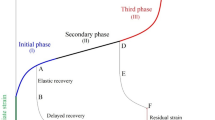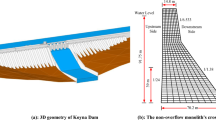Abstract
The seismic response analysis of a tailing dam is studied using a fully coupled effective stress approach in conjunction with an advanced multi yield surface plastic constitutive model for tailing material. Strain controlled static and cyclic triaxial tests were carried out to obtain the constitutive model for the tailing material. The tailing materials were collected from the Rampura Agucha tailing dam (Rajasthan State, India). A 2D nonlinear finite element (FE) model was then developed using different boundary conditions from the tailing embankment constructed using the downstream and upstream method of rising using OpenSees software. In first case, the model boundary was fixed in both the X and Y directions, and in the second case, viscous dashpots were introduced for both side and horizontal boundaries. The model was validated with experimental results on tailing material. Analyses were carried out considering five different earthquake motions, which were applied at the base. Comparisons of the different boundary conditions in terms of displacement flow vectors, pore pressure and stress-strain curves during shaking are presented. From the analysis, it was observed that the viscous boundary condition replicates the actual field conditions more accurately than the fixed boundary condition. In addition, it was found that the tailing embankment constructed by the downstream and upstream method of rising is not susceptible to liquefaction and lateral spreading for earthquake motions, even for a magnitude > 5.5.
Similar content being viewed by others
References
ASTM (1992), Standard Test Method for Load Controlled Cyclic Triaxial Strength of Soil, ASTM, D5311-92, West Conshohocken, PA, USA.
ASTM (1996), Standard Test Methods for the Determination of the Modulus and Damping Properties of Soils Using the Cyclic Triaxial Test Apparatus, ASTM, D3999-91, West Conshohocken, PA, USA.
Basu D, Madhulatha B and Dey A (2019), “A Time-Domain Nonlinear Effective-Stress Non-Masing Approach of Ground Response Analysis of Guwahati City, India,” Earthquake Engineering and Engineering Vibration, 18(1): 61–75. DOI: https://doi.org/10.1007/s11803-019-0490-0
Biot MA (1941), “General Theory of Three-Dimensional Consolidation,” J. Appl. Phys, 12(2): 155–164.
Bureau of Indian Standards (1980a), Test for Soils for Determination of Water Content-Dry Density Relation Using Light Weight Compaction (Reaffirmed 2011), IS: 2720 (Part VII), New Delhi, India.
Bureau of Indian Standards (1980b), Tests for Soils for Determination of Specific Gravity (Reaffirmed 2002), IS: 2720 (Part III), New Delhi, India.
Bureau of Indian Standards (1981), Determination of Shear Strength Parameters of Soil from Consolidated Undrained Triaxial Compression Test with Measurement of Pore Water Pressure (Reaffirmed 2002), IS: 2720 (Part XII), New Delhi, India.
Bureau of Indian Standards (1985), Tests for Soils for Grain Size Analysis (Reaffirmed 2006), IS: 2720 (Part IV), New Delhi, India.
COSMOS (2010a), (Consortium of Organizations for Strong Motion Observation Systems.
COSMOS (2010b), Strong-Motion Virtual Data Center: Update to the Cosmos Converter Tool, 2010. (http://www.cosmos-eq.org/VDC/index.html)
Chung FK and Krinitzsky EL (1977), “Duration, Spectral Content, and Predominant Period of Strong Motion Earthquake Records from Western United States,” Miscellaneous Paper 5-73-1, US. Army Corps of Engineers Waterways Experiment Station, Vicksburg, Mississippi, USA.
Dakoulas P (2012), “Nonlinear Seismic Response of Tall Concrete-Faced Rockfill Dams in Narrow Canyons,” Soil Dynamics and Earthquake Engineering, 34(1): 11–24.
Elgamal AW, Parra E, Yang Z and Adalier K (2002), “Numerical Analysis of Embankment Foundation Liquefaction Countermeasures,” J. Earthquake Eng, 6(4): 447–471.
Elia G, Amorosi A, Chan AHC and Kavvadas MJ (2011), “Numerical Prediction of the Dynamic Behavior of Two Earth Dams in Italy Using a Fully Coupled Nonlinear Approach,” Int. J. Geomech, 11(6): 504–518. doi:https://doi.org/10.1061/(ASCE)GM.1943-5622.0000043
Gazetas G (1987), “Seismic Response of Earth Dams: Some Recent Developments,” Soil Dyn. Earthquake Eng, 6(1): 3–47.
Idriss IM, Lysmer J, Hwang R and Seed HB (1973), “QUAD-4: A Computer Program for Evaluating the Seismic Response of Soil Structures by Variable Damping Finite Element Procedures,” Report No. EERC 73-16, Berkeley, CA: Earthquake Engineering Research Center, University of California, USA.
Idriss IM and Boulanger RW (2010), “SPT-Based Liquefaction Triggering Procedures,” Rep. No.UCD/CGM-10/0, Center for Geotechnical Modeling, Dept. of Civil & Environmental Engineering, Univ. of California, Davis, CA, USA.
IS 1893 (part 1) 2002, Criteria for Earthquake Resistant Design of Structures, Indian Standard Code, New Delhi, India.
Li L, Wang Y and Cao Z (2014), “Probabilistic Slope Stability Analysis by Risk Aggregation,” Engineering Geology, 176: 57–65. doi:https://doi.org/10.1016/j.enggeo.2014.04.010
Lysmer J and Kuhlemeyer RL (1969), “Finite Dynamic Model for Infinite Media,” J. Eng. Mech. Div, 95(4): 859–878.
Newmark NM (1959), “A Method of Computation for Structural Dynamics,” J. Eng. Mech. Div, ASCE, 85: 67–94.
Newmark NM (1965), “Effect of Earthquake on Dams and Embankments,” Géotechnique, 15(2): 139–160. OpenSees (Computer Software), Univ. of California, Berkeley, CA, USA.
Piyush M, Xu D, Suryakant B and Subhamoy B (2021), “A Shake Table Investigation of Dynamic Behavior of Pile Supported Bridges in Liquefiable Soil Deposits,” Earthquake Engineering and Engineering Vibration, 20(1): 1–24.
Prevost JH (1978), “Plasticity Theory for Soil Stress-Strain Behaviour,” J. Eng. Mech Div, 104(5): 1177–1194.
Rampello S, Cascone E and Grosso N (2009), “Valuation of the Seismic Response of a Homogeneous Earth Dam,” Soil Dyn. Earthquake Eng, 29(5): 782–798.
Rico M, Benito G and Díez-Herrero A (2008a), “Floods from Tailings Dam Failures,” Journal of Hazardous Materials, 154: 79–87.
Rico M, Benito G, Salgueiro AR, Díez-Herrero A and Pereira HG (2008b), “Reported Tailings Dam Failures,” Journal of Hazardous Materials, 152: 846–852.
Sanku K, Aniruddha S and Kousik D (2021), “Behavior of Braced Wall Embedded in Saturated Liquefiable Sand Under Seismic Loading,” Earthquake Engineering and Engineering Vibration, 20(2): 361–375.
Schnabel PB, Lysmer J and Seed HB (1972), “SHAKE: A Computer Program for Earthquake Response Analysis of Horizontally Layered Sites,” Rep. No. EERC 72-12, Earthquake Engineering Research Center (EERC), Berkeley, CA, USA.
Seed HB and Idriss IM (1982), Soil Liquefaction During Earthquakes, Engineering Monograph, Earthquake Engineering and Research Institute (EERI), Oakland, CA, USA.
Sitharam TG and Hegde AM (2016), “Stability Analysis of Rock-Fill Tailing Dam: An Indian Case Study,” International Journal of Geotechnical Engineering, 11(4): 332–342. doi:https://doi.org/10.1080/19386362.2016.1221574
Sitharam TG and Hegde AM (2019), “A Case Study of Probabilistic Seismic Slope Stability Analysis of Rock Fill Tailing Dam,” International Journal of Geotechnical Earthquake Engineering, 10(1): 43–60.
Wang Jingyue, Ge Xinsheng, Sun Jingyuan, Liu Yasheng, Shang Zhuo, Wang Zhiqiang and Tian Maoguo (2023), “Dynamic Response Analysis of Liquefiable Ground Due to Sinusoidal Waves of Different Frequencies of Shield Construction,” Earthquake Engineering and Engineering Vibration, 22(3): 637–646.
Yang Z, Elgamal A and Parra E (2003), “A Computational Model for Cyclic Mobility and Associated Shear Deformation,” J. Geotech. Geoenviron. Eng, 129(12): 1119–1127. doi:https://doi.org/10.1061/(ASCE)1090-0241(2003)129:12(1119)
Zienkiewicz OC, Chan AHC, Pastor M, Schrefler BA and Shiomi T (1999), Computational Geomechanics (with Special Reference to Earthquake Engineering), John Wiley & Sons Chichester, UK.
Author information
Authors and Affiliations
Corresponding author
Rights and permissions
About this article
Cite this article
Vijayasri, T. Dynamic characterization of tailing dam using fully coupled dynamic analysis with different boundary conditions — a case study. Earthq. Eng. Eng. Vib. 22, 995–1013 (2023). https://doi.org/10.1007/s11803-023-2218-4
Received:
Accepted:
Published:
Issue Date:
DOI: https://doi.org/10.1007/s11803-023-2218-4




